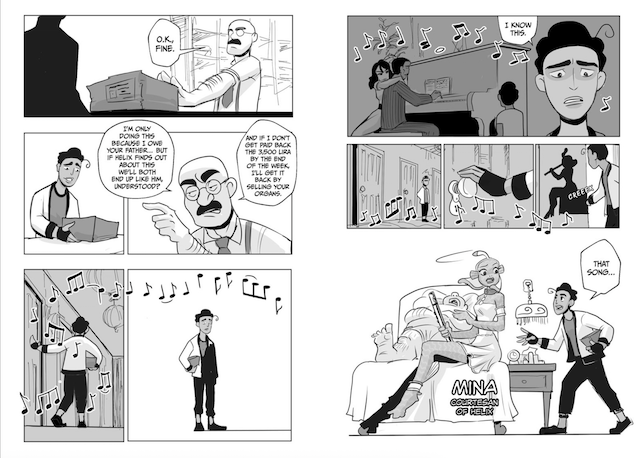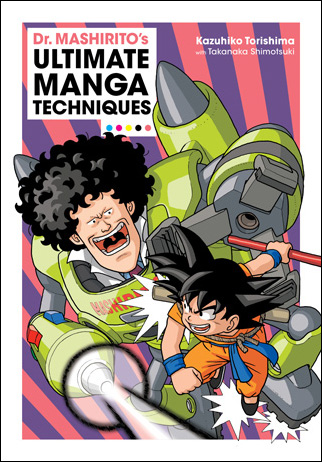Your source for in-depth interviews, manga spotlights, and expert advice for your life as a mangaka.

In this month’s newsletter, we explore the respect for mangakas that every editor must have with VIZ Originals One-Shots editor Hisashi SASAKI and welcome more advice from Kazuhiko Torishima, author of Dr. Mashirito’s Ultimate Manga Techniques. Plus, let’s all take a moment to slow down and appreciate the resonant world of Jonathan Lareva’s “Ancient Melody”!
CONTENTS:
In Conversation With Manga Editor Hisashi SASAKI
In Perspective- “Ancient Melody”
Dr. Mashirito’s Ultimate Manga Techniques: The Clincher Is Action!
New and Upcoming from VIZ Originals

In one of our previous interviews, VIZ Originals One-Shots editor Hisashi SASAKI said, “Since [Shonen Jump] is a weekly magazine, mangakas and I would meet every week to discuss the upcoming issue. I would share all the ideas I could think of, but they rarely incorporated them. Instead, they would come up with more intriguing ideas and develop them into thumbnails. This realization led me to conclude that only mangakas capable of generating ideas that transcend the imagination of editors can achieve professional success.” This is an interesting point of view and seems vital to understanding the role of an editor in relation to the mangaka. We dig a little deeper into that idea this month.
Are there any traits or skills that successful editors must have?
Hisashi SASAKI: Well, when we discussed this subject, I was referring to the traits of successful mangakas. And for some reason, using the term “successful” to describe editors does not sit well with me. But if you're asking about traits that every manga editor should possess, the first thing that comes to mind is unconditional respect for mangakas, regardless of their popularity, whether they are professionals or amateurs. Without this respect, it’s impossible to review their manga fairly. We can’t treat all mangakas equally, and we shouldn’t. But we must treat them fairly. Otherwise, we won’t be able to identify the right talent in the right mangakas.
Pace is important to process. Some mangaka can draw beautiful pages, but only if they have days and days to work on the page. If you have a mangaka who is talented but slow, what can you do as an editor to guide, help, or encourage them?
SASAKI: Honestly, there’s not much we can do about it 😅. I believe that drawing speed is part of their talent. However, as I’ve observed, as they gain more experience, talented mangakas develop methods to speed up their production without compromising the quality of their art.
In addition, it sounds like the editor/mangaka relationship needs regular check-ins and brainstorming together to keep the mangaka’s work sharp. How much is too much? How can you tell whether or not you’re bothering the mangaka, rather than helping them?
SASAKI: Well, it entirely depends on each mangaka. If there are 100 mangakas, there are 150 different ways to interact with them. The most crucial aspect is to get to know them very well.
The Western manga scene has a few differences from the Japanese one, particularly in the absence of assistants. What appeals to you about the Japanese system of assistants working alongside mangaka to produce manga? Do you think a similar system has potential to work here?
SASAKI: Back in the days when I was a front-line editor, if you worked as an assistant to a popular mangaka who serialized on a weekly basis, you’d stay in their studio for three or four days a week and do nothing but draw manga. There were usually several other assistants, and since they were also aiming to become pros, the topic of conversation was naturally manga. In this environment, you could learn professional work methods and techniques while competing with each other, and you also got paid. I think the Japanese assistant system was the best kind of on-the-job training if you wanted to be a mangaka. Since the pandemic, I’ve heard that things have changed a lot and a lot of assistants are now working remotely, so that close-knit community of mangaka assistants has become difficult to form. I am curious how this systemic change will affect the manga scene in Japan.
When looking at the Western manga industry, it’s evident that not many mangakas can afford to hire assistants due to the smaller market compared to Japan. Additionally, in the case of the United States, even if assistants are hired, the vastness of the country makes it unrealistic for them to commute to studios every week. However, advancements in technology have made it possible to hire assistants from distant locations. Furthermore, tools for communication among aspiring mangakas continue to improve, facilitating the growth of online communities. If the Western manga market expands and technology continues to progress, I believe it’s feasible to establish a close-knit, serious, and healthy community of aspiring mangakas akin to those in Japan.

In Perspective is a chance to show our appreciation for the craft and care mangaka have put behind their one-shots. This one was written by David.
A one-shot has to introduce an audience to an all-new world featuring all-new characters, and a mangaka has to accomplish that within a limited number of pages. It has to introduce new characters and a setting, and even deliver a compact narrative arc before it’s over. Does that sound like a challenge? Success with one-shots can be a tall order, but Jonathan Lareva’s “Ancient Melody” makes the grade by emphasizing compelling characters and delivering an intriguing mystery punctuated with high personal stakes. In other words—“Ancient Melody” is the total package.
Olan is a scavenger, a talented young thief who hunts rare objects in exchange for money. Desperate to raise money for a secret reason before it's too late, Olan takes on risky jobs. Despite the desperation, he moves with intelligence and wit, too. He has a goal and he’s moving toward it steadily at a nice drumbeat of a pace. But he can’t do everything himself. He’s a small-time thief with no real backing. He’s on the cusp, just one failed job from never being able to achieve his dream. He needs more.
Fortunately, the world he lives in is filled with (figurative) echoes of his late father to help guide his way. Olan’s father was a high-ranking gangster who did his best to behave with honor and dignity, and that has left a mark on people. When the people Olan meets remember his father, and he takes advantage of things set in motion long ago, The world of “Ancient Melody” is enriched when Olan meets people who remember his father, or when he takes advantage of things his father set in motion long ago. The world feels well-established and well-rounded. The events of the story are given that much more weight thanks to the relationship between Olan and his father.
The story feels more real to me because connections with other people abound in our own lives, just as in Olan’s, and that familiarity helps us believe in “Ancient Melody.” If you grew up in the same town as your parents, you’ve undoubtedly met someone who knows them, and that person may be able to reveal something new about them to you. At the very least, they should be able to share an embarrassing anecdote, right?
Following and using these connections leads Olan closer to his goal, and deeper into a criminal underworld that his father once explored himself. His father had a life Olan was not privy to, just as our parents have a life that we are not privy to, and “Ancient Melody” is as much about Olan achieving his goal as finding confirmation that his father really was the man he appeared to be.
Lareva’s approach to world-building and storytelling is heavy on the charm, and filled with relatable characters and situations. These familiar elements ground the more fantastical elements of the story—there’s a flaming sword on the title page!—making it easy for audiences to suspend their disbelief and embrace the out of the ordinary. The flying ships, flutes with otherworldly powers, and ancient technology are a keen counterpart to the relatable emotional stakes, friendships, and thornier relationships in the story. It all builds to a very nice package.
I’ve just thrown a spotlight on characters and connections here, but Jonathan Lareva’s “Ancient Melody” packs a lot more into its 49 pages. If you enjoy expansive sci-fi with down-to-earth stakes, this one-shot is a great choice.

“The highlight of Dragon Ball is the speedy and dynamic action… However, fighting battles are not the only form of action in manga. Of course, intense battles are the distinctive appeal of shonen manga, but being able to dramatically depict fights in a non-violent manner—whether it be through games, a battle of wits, or a tangled web of romance—is also a part of shonen manga. If you consider all of that to be action, then it’s safe to say that action is absolutely essential as an element to make a shonen manga come alive.”
—Kazuhiko Torishima (Dr. Mashirito’s Ultimate Manga Techniques, page 29)
Curryuku’s upside-down romance Not So Shoujo Love Story, volume 2 (Available Now!)
Akira Himekawa’s fantasy/adventure manga Kamudo, volume 1 (October 2025)
GRAVEWEAVER’s supernatural mystery I’m The Grim Reaper, volume 4
(November 2025)
Sign up here to get the latest VIZ Originals Creator Newsletter straight to your email!
Already have a VIZ account? Log in.
Don't have an account? Sign up.
Enter the e-mail address associated with your account and we'll email you a link to reset your password.